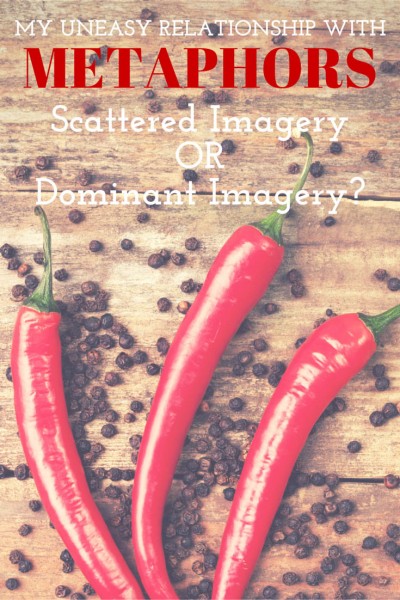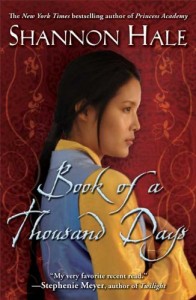There’s an apocryphal story about a writer who worked hard all day. In the morning, he inserted a semi-colon; in the afternoon, he removed a semi-colon.
This morning, I inserted a metaphor; this afternoon, I removed the metaphor.
Metaphors continue to be a thorn in my side. I appreciate when I’m reading a story or novel and there’s an apt metaphor. It adds to my enjoyment because it expands the story and creates new connections. Such glimpses into the thought process of another human are one of the joys of reading.

Yet, when I sit down to write, I’m practically metaphor free. Partly, it’s because I find it tedious to sit down and add metaphors just because someone says my prose would improve with the use of metaphors. But as I’ve thought about it more, I’ve decided my problem is the difference in dominant vs. scattered imagery.
Dominant vs. Scattered Imagery
In their work of genius, How Does a Poem Mean, Miller Williams and John Ciardi discuss “The Image and the Poem” in Chapter 6. I refer you to their book for a full discussion of imagery, metaphors, similes and so on. For my purpose, though, let me concentrate on the question of dominant and scattered imagery. Here’s what Williams and Ciardi say:
“When the images of a given poem, or of a given passage, are related by their denotations, that poem or that passage is said to be constructed on a dominant image. When the images are related by their connotations but range widely in their denotations, that poem or passage is said to make use of scattered imagery.” (p. 247)
 Here are some imagery (metaphor/similie) from Shannon Hale’s Book of a Thousand Days
Here are some imagery (metaphor/similie) from Shannon Hale’s Book of a Thousand Days
- P. 1 I feel like a jewel in a treasure box. . .
- p. 2 Stay until your heart softens like long-boiled potatoes. . .
- p. 2 . . .skinny as a skinned hare.
- p. 8 It (the candle flame) tosses and bobs like a spring foal. . .
- p. 11 My heartache felt like a river, and I was sinking into it, carried away fast in its coldness.
- p. 12 . . if all they find is a delicate lady and her humble maid shriveled like ginger roots
- p. 13 I feel like a mucker from the ends of my hair to the mud of my bones.
- p. 13 It (lord’s house) was near as beautiful as a mountain in autumn. . .
- p 15 she sat on her bed, alone, straight as a tent pole
- p. 16. . . they resembled my own deel (clothing)as much as a worm resembles a snake.
- p. 18 . . . my lips thinner than the edge of a leaf.
- p. 18 He slapped his daughter’s face. . . like a snake striking.
- p. 20 She (Lady Saren) reminded me of a lamb just tumbled out, wet all over, unsure of her feet and suspicious of the sun.
Taken together, they don’t create a dominant image; Hale is using scattered imagery in a masterful way. Each image is directly related to the immediate situation. They don’t add up to a bigger image at the end—the collection of images don’t combine to create any symbolism.
Most of the time, when people mention the need for more metaphors in a piece, they mean this sort of scattered imagery.
However, when I write, I tend to write for a dominant image, using symbolism more than metaphors. The principle of selection of details for me is a wider scale. I’m looking for imagery that spreads across a whole chapter or even a whole novel.
Miller and Williams call this an overtone theme. (p. 110) They analyze the themes in a selection from John Milton’s Paradise Lost, concluding that Milton chose words and images based on two themes to describe the Biblical serpent who visited Eve: watery motion and regal splendor. A third category is when the two themes mesh.
Here’s a catalogue of the language:
- Watery Motion: indented wave, circular base, rising folds, fold upon fold, surging maze, floated redundant
- Regal splendor: carbuncled, burnished, gold, circling spires
- Combination of water and regal: towered, crested aloft
They say, “Whatever the value of such a tabulation, it cannot fail to make clear, first, that a unified principle of selection is at work in this diction, and second, that the words are being selected from inside their connotations and in answer to one another’s connotations, rather than from inside their denotation.”
Milton chose words/phrases because when they banged up against another word/phrase, they changed each other slightly. Circling spires weren’t just an architectural delight; instead, they hinted at regal splendor.
When I write, this is what I’m trying for: connotations speaking to connotations. I hope that I create a cumulative dominant image. I choose words based on certain themes and then work to make them collide.
Tips on Scattered Imagery
One reason I’m not fond of scattered imagery is that in the hands of a novice, it jerks me out of the current story. Here’s an example.
Setting: The principal tells you that you’ve won a scholarship, but to get it, you must accept an exchange student into your home for a year.
“. . . awesome news tossed into her lap like a grenade.”
Setting: A girl is thinking about a weird boy.
“ Thinking about him made her stomach hurt like she’d eaten a dozen McDonalds burgers at one sitting.”
These similes are easy to understand, contemporary, and not my favorite. In the first situation, a grenade carries the connotation of war, shock, and a shattered body. It’s too much for my taste because it pulls me out of a teen novel and instead, puts me in the Vietnam or Iraqi War.
In the second situation, I certainly understand that a dozen burgers (from anywhere) eaten in one sitting would give you a tummy ache. But how does this relate to the situation? It didn’t relate for me.
Hale sticks to imagery related to the immediate scene.
Setting: The princess and her maid are forced to become scullery maids in order to eat.
“Stay until your heart softens like long-boiled potatoes. . .”
In a kitchen setting, this makes sense. It also relates to the character who comes from the country and is familiar with the humble potato.
When you use scattered imagery, then, especially metaphors and similes, give them deep roots in the setting, not just a reference to a general cultural region.
And when you critique writing for others, remember the range of possibilities. Certainly, I always need to be challenged to use deeper imagery; but maybe, I don’t need to worry so much about just the one option for imagery called the metaphor.
If metaphors are added later, as an afterthought, do they not seem laboured? I am very nervous about adding metaphors during the second draft. I worry that I will need to remove them later, as in the introduction to this entry. Are there any other views on this?
I don’t have problems adding metaphors later. It doesn’t seem to affect the flow of the story. Of course, you’ll have to re-read to make sure the ones you add are apt.